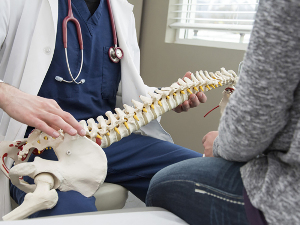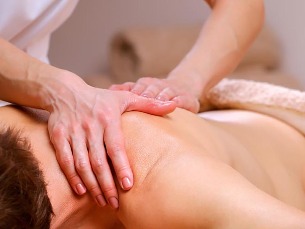Symptoms and treatment of lumbar osteochondrosis will be discussed more, a person's mobility is limited, the ability to lead a normal life. Almost half of all patients have pain in this part of the lower back. According to the results of the survey, lumbar osteochondrosis is second only to respiratory diseases.
Until recently, age-related degenerative processes were considered the main cause of pathology, but now more and more factors that cause the disease have been identified. Before starting therapy, you need to understand what lumbar osteochondrosis is.
The disease is a pathological change of ligaments in the intervertebral discs, accompanied by the destruction of the vertebral bodies themselves. The most painful is the lumbar region, because it carries a large load when lifting weights in a sitting position.
Symptoms of lumbar osteochondrosis are becoming more common in young people in their 30s. It is impossible to start the disease, because the complications are fraught with disability, paralysis of the lower extremities.
The main symptoms of lumbar osteochondrosis
Lumbar osteochondrosis is a deforming pathology that is often a natural aging process. However, high physical activity in the spine, metabolic diseases, the use of harmful products and alcohol accelerate this process.
The first signs of pathology do not appear immediately, so therapy does not always start on time. The symptoms of lumbar osteochondrosis are as follows:
- The pain is mostly in the early stages and is acute in stages 2-3 of the disease (with any sudden movement, the discomfort is exacerbated and passes during bed rest);
- With osteochondrosis, there is a feeling of weakness in the legs (tendon reflexes disappear in the lower extremities, which is clearly seen during neurological tests);
- curvature of the lumbar region;
- Disorders of urination and defecation (due to where the spinal cord is compressed).

Additional symptoms of lumbar osteochondrosis can also be identified: numbness in the lower back, dryness and peeling of the skin, changes in the shade (turns blue). Sweating increases in the hip area. One of the symptoms of osteochondrosis of the lumbar spine in men is erectile dysfunction.
Symptoms of lumbar osteochondrosis vary in severity. Some manifestations can be combined with syndromes.
| syndromes | characteristic |
| Ischemic | Here are the symptoms of osteochondrosis of the spine due to damage to blood vessels. Vascular spasm begins (persists over time). This condition is characterized by pain in the muscles of the lower legs and thighs while walking. If the blood vessels constrict and spasm for a long time, nutrition, as well as the functionality of the pelvic organs, is impaired. In women, pathology, menstrual cycle, the ability to conceive a child, causes problems with urination |
| Vertebral | It is characterized by pain of varying intensity and localization. Occurs after a load on the lower back: bending, lifting heavy objects. If a herniated disc forms, the person may lose sensitivity in the legs. In this situation, changes occur in the spine: posture changes, the person stretches, gait becomes problematic |
| Radical | Vertebrae become unstable, squeezing not only nerve roots, but also blood vessels. One symptom of the syndrome is pain at the site of compression of the tips. Unpleasant sensations spread to the thighs and legs. A person has an increase in muscle tone, is forced to change gait. In the absence of treatment for osteochondrosis, the nerve roots become inflamed. This condition is accompanied by edema in the tissues of the body around the spine. The blood begins to stagnate, the process of intoxication begins. With radicular syndrome, pain is observed in other joints. In addition to these symptoms, there is a feeling of "gas bumps" in the lower back (lumbar region). Especially in difficult cases, patients can no longer move independently |
People suffering from lumbar osteochondrosis should undergo a thorough examination to find out how severe the disease is and to determine a therapy regimen.

Degrees of lumbar osteochondrosis
Lumbar osteochondrosis develops gradually. There are the following stages of pathological development:
- First. In this case, the pulposus nucleus inside the disc begins to move and change. Cracks appear in the fibrous ring. Nerve roots are irritated, which indicates back pain. At this stage of osteochondrosis, the discomfort is still local, meaning that the symptoms are felt only in the area of the damaged disc. Sometimes it is a lumbago, but in the early stages of development there is often a persistent dull pain. Anxiety in osteochondrosis increases after the load on the lower back.
- Second. Here the destruction of the fibrous ring takes place. The mobility of damaged vertebrae increases, muscle tissue becomes tense. The distance between them is reduced, they can move relative to each other. It is more difficult for a person to move because he gets tired quickly and feels serious discomfort in the lower back. The pain spreads to the thighs, legs and hips. Man sweats more.
- Third. At this stage of the disease, the pain intensifies several times, as the fibrous ring breaks. In this case, the nucleus pulposus separates and a hernia forms. The patient feels sharp pain and lumbago when the tissues and nerve roots are compressed. Anxiety is persistent and unbearable. The work of internal organs is violated.
- Fourth. Deformation of the spine occurs. It is very difficult for a person to move, but the pain symptom is less pronounced. This does not mean that the pathology has not yet developed. This situation is a signal that a person will soon be in a wheelchair. In addition, osteophytes grow in the area of the damaged disc, aggravating the condition, muscle atrophy.
If the disease is not controlled and treatment is not started on time, the vertebrae will simply collapse and recover without a risky and difficult operation.
What to do if the disease worsens
Lumbar osteochondrosis is a difficult disease that should not be brought to the final stage. It quickly becomes chronic, because even the most effective treatment can only stop or slow down the development of pathology.
If there is severe back pain and the person is unable to move normally, it indicates an exacerbation of the pathological process. It often occurs in patients who do not follow the recommendations of doctors. If there is violence, a person must follow these rules:
- It is better to completely abstain from physical activity for the period necessary to restore normal body function. It is better to sleep in a comfortable position that does not cause discomfort. It is better if the patient uses a firm mattress, because the body does not shake in this position (especially in the lumbar region).
- A person can use a semi-rigid corset to minimize the load on the back. It will limit sudden movements.
- To reduce the severity of pain in osteochondrosis, you should slowly bend your leg on the affected side to your knee. This will help relieve muscle tension and relieve compressed nerve tissue.
- In difficult cases, the applicator can be used, but should be used with caution. The procedure is performed twice a day for 30 minutes.
- You should use an anti-inflammatory ointment after a massage that gradually restores normal blood circulation and muscle tone.

It is not possible to warm the affected area on the first day after the onset of exacerbation. Dry heat is applied only on the second day after the peak of pain. Otherwise, tissue edema will increase and the condition of the patient with osteochondrosis will worsen.
Diagnosis of the disease
Lumbar osteochondrosis requires a serious approach and complex therapy. It is easier for the patient if he takes the right medication and follows the doctor's instructions. The patient should be examined to select a therapy regimen. The following diagnostic methods are noteworthy:
- x-ray. If the lumbar joints are affected, X-ray examination is considered essential. The picture is taken in the form of several projections. You can see the damage to the discs, the condition of the spinal canal. Each projection must be perpendicular to the previous one.
- MRI or CT. The presented procedures help to more accurately determine which factors cause the development of osteochondrosis, in which case not only the vertebrae, but also soft tissues, blood vessels, nerve endings. At the same time, the person does not feel any discomfort.
- External examination with palpation of the affected area and neurological tests.
Only a thorough diagnosis will determine whether a person has actually developed osteochondrosis.
Treatment of lumbar osteochondrosis
If lumbar osteochondrosis is not treated, the patient develops complications such as protrusion, spondyloarthritis, hernia, inflammation of the sciatic nerve, narrowing of the spinal canal, dysfunction of the pelvic organs. The person also begins to lose weight, has paresis and paralysis of the legs.The treatment of lumbar osteochondrosis involves several tasks. First, it is necessary to eliminate the inflammation that causes pain in this disease. Of course, you need to stop the unpleasant symptoms themselves, as well as strengthen the muscle corset in the lower back and lower extremities.
Therapy should eliminate swelling and soft tissue spasms. The patient is prescribed tools and procedures designed to improve the functioning of the organs, regulate blood circulation, restore metabolic processes in the body and expand the range of motion. Patients with osteochondrosis of the lumbar spine should be treated for a long time, so you should choose methods that work well and cause minimal damage. Medications, alternative therapies, physiotherapy, LF and other methods are used.
Surgery
In advanced cases, when the disease reaches its final stage, surgical intervention is required for osteochondrosis of the spine. The help of a surgeon is needed when there is a complication that disrupts the functioning of the organs, a vertebral hernia. If there is a risk of paralysis of the lower extremities, emergency surgery is performed.
The most effective intervention is to remove the damaged disk. Microsurgical treatment of lumbar osteochondrosis using an endoscope is also widespread. This procedure is less traumatic for the patient and allows him to recover as soon as possible.
Physiotherapy
Symptoms of lumbar osteochondrosis (treated in different ways) can be relieved with the help of physiotherapy procedures. Useful:
- diadynamic currents;
- electrophoresis and phonophoresis;
- magnetic therapy;
- laser treatment.
Physiotherapy procedures will give maximum benefit in combination therapy with medication.
Physiotherapy exercises
Treatment of lumbar osteochondrosis will not be effective without a set of exercise therapy prescribed by a doctor. All exercises are aimed at improving lumbar mobility, strengthening the muscular corset and increasing the stability of the spine. The complex should be implemented regularly.
The doctor usually prescribes the following exercises: inclinations in different directions, walking on all fours, on all fours and back, tension of the abdominal muscles in the supine position.

Massage
It can be done only after the exacerbation is eliminated or during remission. Thanks to the procedure, you can not only relax the spasmodic muscles, but also strengthen them. Massage is more effective after a bath. It should be carried out by a specialist using the right techniques: rubbing, rubbing. If there are open wounds on the back, a person is diagnosed with dermatological diseases or circulatory problems, the procedure can not be performed.
Manual therapy
Manual therapy solves the same tasks as massage, but uses slightly different methods. You can't trust your spine to an amateur. The procedure requires an experienced specialist who will not cause harm.
Medication
Medications cannot be given in the treatment of lumbar osteochondrosis. When choosing them, the general condition of the body, the stage of development of the disease are important. There are the following most effective groups of drugs to combat osteochondrosis:
Analgesics.
- NSAIDs - These drugs relieve the inflammation itself and the pain that accompanies it. Eliminates puffiness, normalizes body temperature.
- Muscle relaxants - These medications are prescribed by a doctor and are only used when NSAIDs fail. Muscle relaxants help relieve muscle spasms.
- Chondroprotectors - Keep cartilage in good condition without allowing it to break down. However, they are only effective if this layer is not completely removed.
- Steroid anti-inflammatory drugs. In the most advanced cases, the latter are appointed.
- Multivitamins and B vitamins - The drugs provided help to improve the functioning of the NS.
- Antidepressants (to restore the patient's emotional background).
- Novocaine blockade with hydrocortisone. They are placed directly inside the area where the pain occurs. Blockades are rarely performed because they can cause muscle atrophy.
- Preparations to improve blood circulation and microcirculation.
Topical ointments have good efficacy and minimal side effects. If the patient uses folk remedies for therapy, the medication should be continued.
Prevention of lumbar osteochondrosis
Osteochondrosis of the spine can be prevented if you follow simple prevention rules:
- Avoid hypothermia and infection;
- Do not lift heavy objects;
- bags to be worn alternately on both shoulders;
- follow a drinking regimen and eat properly;
- maintain a normal body weight;
- timely treatment of congenital or acquired skeletal pathologies;
- Get in for a swim, exercise more, do a gymnastics complex for the lumbar region every day;
- undergoes regular medical examinations.
Basic care for your health will help prevent complications of osteochondrosis of the spine, and there are many, and they are difficult to cope with.

















































